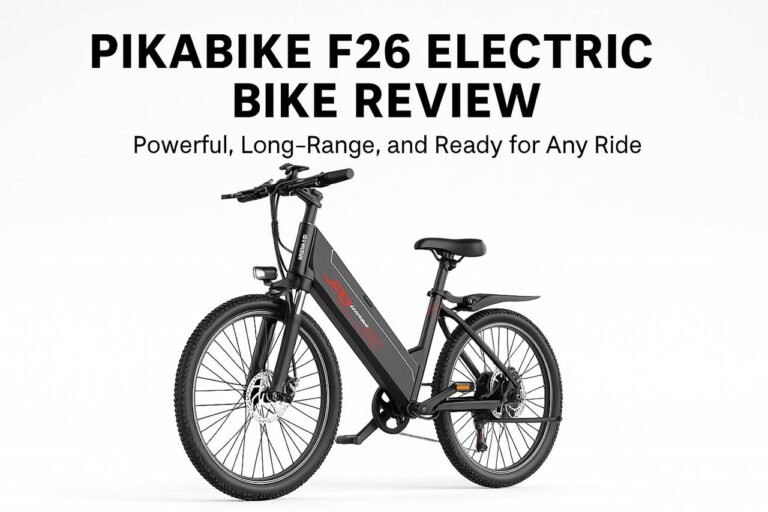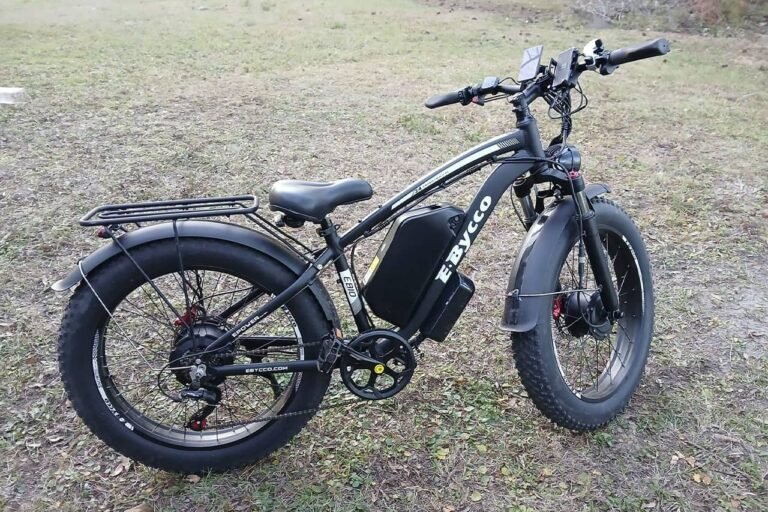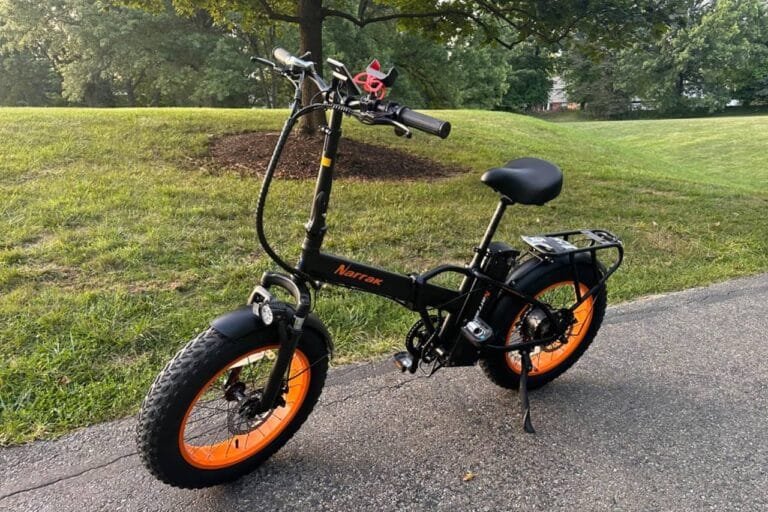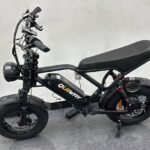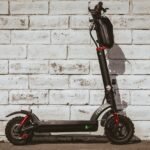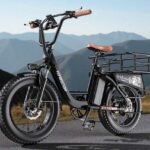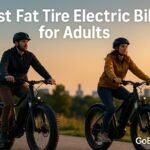![The Longest Range E-Bikes in [year]: Big Batteries, Bigger Real-World Miles Best Longest Range E-Bike](https://goebikelife.com/wp-content/uploads/2024/08/Best-Longest-Range-E-Bike.jpg)
If your perfect ride looks like one charge, all day, this guide is for you. Below, you’ll find everything you need to choose a truly long-range e-bike in 2025—how range really works (and why listings vary), which components matter, and how to squeeze more miles from any battery. We’ll also spotlight six long-range models that riders consistently shortlist for distance riding:
- Wallke H7 AWD – monster-size pack, traction for varied terrain
- E·Bycco EB7 PRO – rare mix of high power and serious stamina
- FREESKY Swift Horse Pro – big-cell battery + Bafang muscle
- EYBAIKC E100 PRO – versatile platform with upgradeable battery options
- Cybervelo EK6 Max (2.0) – compact 20″ fat-tire with a serious pack
- TESWAY X5 PRO – utility step-thru with an ultra-large battery for family/cargo
Bottom line up front: For maximum distance per charge, prioritize battery watt-hours (Wh), keep cruising speeds moderate (18–22 mph / 29–35 km/h), and ride in lower PAS levels with steady cadence. A well-tuned 1.4–3.0 kWh battery ridden smartly will deliver surprisingly long days.
1) What “Range” Really Means (and Why Claims Differ)
Marketers love “up to XXX miles.” Real riders live in the middle of a spread. To make sense of it, focus on:
1.1 Battery Capacity in Watt-hours (Wh)
- Wh = Voltage × Amp-hours.
- Think in energy, not just volts or amp-hours. A 48 V × 20 Ah pack is ≈ 960 Wh; a 52 V × 32 Ah pack is ≈ 1,664 Wh; a 48 V × 60 Ah pack is ≈ 2,880 Wh.
- Most bikes don’t give you 100% of that; BMS reserves and voltage curves mean you typically use 85–95%.
1.2 Consumption in Wh/mi (or Wh/km)
Your real-world “mpg.” It’s driven by:
- Speed (the biggest factor—air drag rises exponentially above ~20 mph / 32 km/h)
- Assist level / throttle use (full-throttle and AWD chew energy)
- Rider + cargo mass, hills, surface, tire pressure, temperature, wind
- Drive type (mid-drives tend to climb more efficiently; AWD hub prioritizes traction over efficiency)
1.3 Practical Consumption Bands
- Eco PAS, 15–18 mph (24–29 km/h): ~12–15 Wh/mi (7.5–9.5 Wh/km)
- Mixed PAS/throttle, 18–25 mph (29–40 km/h): ~18–25 Wh/mi (11–16 Wh/km)
- Aggressive + hills + AWD: ~25–35 Wh/mi (16–22 Wh/km)
Quick math: Range ≈ Battery Wh ÷ Wh/mi.
A 2,880 Wh pack at 15 Wh/mi ≈ ~192 miles (309 km). At 25 Wh/mi ≈ ~115 miles (185 km). Same bike, different riding style.
2) The Components That Actually Extend Range
2.1 Battery (Cells, Safety, Charging)
- Prefer named cells (Samsung, LG, Panasonic) and clear specs.
- UL 2849 (system) and UL 2271 (battery) certifications are strong safety signals—particularly important for large packs.
- Chargers: higher-amp chargers cut time but add heat; more on charging strategy below.
2.2 Motor & Controller
- Single hub: simpler, typically more efficient at steady speeds.
- AWD dual hub: traction and punch when needed, but more consumption if you run both motors at speed.
- Controller tuning defines how abruptly power arrives and how well PAS levels scale—fine-grained PAS helps you stay efficient.
2.3 Drivetrain & Cadence
- 7–9 rear speeds with sensible gearing avoid spin-out at 20–23 mph, letting you pedal along efficiently in PAS 1–2.
2.4 Tires & Pressure
- Fat tires add comfort and capability but increase rolling resistance. Run appropriate PSI (lower for off-road, higher for pavement) and check weekly.
2.5 Brakes & Rotors
- Long-range builds are heavier. Look for hydraulic discs and large rotors (180–203 mm) to keep stopping distances reasonable.
2.6 Weight & Payload
- Bigger batteries weigh more. If you plan to haul cargo or kids, confirm payload rating and match brakes/suspension accordingly.
3) How to Estimate Your Range in 60 Seconds
- Find your Wh (e.g., 48 V × 30 Ah = 1,440 Wh).
- Pick a band for your typical ride:
- City eco PAS → 14 Wh/mi
- Mixed suburban → 22 Wh/mi
- Hilly/aggressive → 30 Wh/mi
- Compute: Range (mi) = Wh ÷ Wh/mi.
- Adjust: Subtract ~10% for wind, cold, heavy loads, or frequent stops.
4) 6 Long-Range E-Bikes Worth Shortlisting
Notes: Model families can have region-specific trims. The highlights below reflect commonly listed configurations as of 2025. Always verify the exact battery/motor package on the live product page before purchasing.
4.1 Wallke H7 AWD — Maximum Battery, Minimal Anxiety
Why riders pick it: A true battery behemoth in the consumer market. Riders who tour mixed terrain for hours love the AWD traction and the oversized pack that flattens range anxiety.
Who it fits: Adventure-tourers, rail-trail explorers, riders who mix pavement with sand, snow, or gravel.
Standout traits:
- Very large-capacity pack (often cited around the 2.9 kWh class)
- Dual-hub AWD for traction at launches and on loose surfaces
- Full suspension and fat tires for comfort and control
- Many listings reference UL safety credentials
Reality range game plan: Keep PAS at 1–2 and cruise ~18–21 mph; reserve the front motor for steep grades or slippery conditions.
Potential tradeoffs: Weight, added complexity from AWD, and the temptation to “use the power” (which increases Wh/mi).
Smart add-ons: Suspension seatpost if not already included; sturdy rear rack with panniers; 4-piston brake upgrade if your trim lacks it.
4.2 E·Bycco EB7 PRO — High-Power Fun Meets Real Stamina
Why riders pick it: Unusually large 52 V platform with a big amp-hour pack paired to robust dual motors. It’s a rare value play if you want both punch and range.
Who it fits: Hillier locales, mixed surface riding, riders who want to feel “sport mode” but can dial it back for distance days.
Standout traits:
- 52 V architecture with a large-capacity (30 Ah+ class) battery option
- Dual-motor acceleration for steep city climbs or sand/snow
- Full suspension to take the edge off long rides
Reality range game plan: Live in PAS 1–3 for flats; tap dual-motor only when needed. Speeds in the 18–23 mph band conserve a surprising amount of energy.
Potential tradeoffs: Frequent 30–40+ mph blasts will cut range dramatically (true for any e-bike); heavier than commuter singles.
Smart add-ons: Metal pedals, spare charger at work, puncture-resistant tire liners.
4.3 FREESKY Swift Horse Pro — Big-Cell Battery + Bafang Confidence
Why riders pick it: A balanced long-range build with a named motor brand (Bafang) and a high-capacity Samsung-cell battery.
Who it fits: Riders who split time between pavement and gravel, want comfort at speed, and value component provenance.
Standout traits:
- Large-capacity 48 V pack (often around 30 Ah class) using Samsung cells
- Bafang hub for reliable torque and serviceability
- 26″ fat tires and full suspension for rough surfaces
Reality range game plan: Inflate tires toward the pavement end of the range when riding roads; keep cruise at 18–22 mph; PAS 1–2 on flats.
Potential tradeoffs: Fat tires add rolling resistance; confirm your local-market motor rating and speed cap.
Smart add-ons: Fold-out repair kit, quality floor pump with gauge, chain wax.
4.4 EYBAIKC E100 PRO — Upgradeable Battery Path
Why riders pick it: A flexible dual-motor platform frequently sold with a 52 V, low-to-mid-20s Ah stock battery—and often supported by higher-Ah replacement packs.
Who it fits: Budget-conscious long-range seekers who want to start smaller and upgrade later; all-terrain commuters.
Standout traits:
- 52 V architecture with 23 Ah stock and higher-Ah upgrade options seen in the wild
- Hydraulic brakes and full-suspension fat-tire comfort on many trims
- Dual-motor confidence for bad weather or steep neighborhoods
Reality range game plan: With the smaller pack, ride conservative PAS and steady cadence; with the larger upgrade, you can add speed or cargo without sweating your return leg.
Potential tradeoffs: Listings differ by region—verify your exact SKU (controller/motor/battery).
Smart add-ons: Uprated headlight for faster night commutes; spare battery key; U-lock mount.
4.5 Cybervelo EK6 Max (2.0) — Compact Wheels, Serious Distance
Why riders pick it: A 20″ fat-tire package that still brings a larger-than-average battery—and a magnesium frame for a different feel and look.
Who it fits: Riders who prefer a compact wheelbase for storage/transport but don’t want to compromise on battery capacity.
Standout traits:
- 48 V pack often listed around 25 Ah
- 1,000 W class hub with peppy peak output
- Magnesium frame; 8-speed drivetrain on many trims
Reality range game plan: Smaller wheels are lively, but keep top speeds reasonable to avoid drag penalties; run appropriate PSI (higher for pavement) to cut rolling losses.
Potential tradeoffs: At 30+ mph on 20″ wheels, braking distance and handling demand attention—make sure your trim has strong rotors/pads.
Smart add-ons: Rear cargo platform, pannier set, front mudguard with longer flap.
4.6 TESWAY X5 PRO — Ultra-Large Battery Meets Everyday Utility
Why riders pick it: A practical step-thru, cargo-friendly frame paired to an ultra-large battery often cited in the ~2.9 kWh class—a unicorn combo for families, couriers, and distance commuters.
Who it fits: Delivery routes, kid seats, grocery hauls, or anyone who wants to do two long rides on one charge.
Standout traits:
- Very high-capacity 48 V pack (often around 60 Ah)
- Utility geometry: step-thru frame, suspension comfort, stout racks
- 4-piston hydraulics on many trims; payload-forward design
Reality range game plan: Even with cargo, you can comfortably plan century-class days if you keep speeds in the ~18–22 mph band and PAS low.
Potential tradeoffs: Bike mass (parking, carrying up stairs); longer recharge windows with standard chargers.
Smart add-ons: Dual-leg center stand, child seat with rails, frame-mounted lock, reflective sidewall tires.
5) Comparison Snapshot (What to Expect at a Glance)
- Battery class:
- H7 AWD / X5 PRO: “Ultra-large” (≈ 2.8–3.0 kWh class)
- EB7 PRO: “Large” (≈ 1.6 kWh class)
- Swift Horse Pro: “Large” (≈ 1.4–1.5 kWh class; Samsung cells)
- E100 PRO: “Medium-large” stock (≈ 1.2 kWh), upgradeable to large
- EK6 Max: “Medium-large” (≈ 1.2 kWh) in a compact format
- Use-case fit:
- Touring & mixed surface: H7 AWD, Swift Horse Pro
- Hilly cities / power + distance: EB7 PRO, E100 PRO (upgraded)
- Compact storage with long rides: EK6 Max
- Cargo/utility distance: X5 PRO
- Efficiency levers:
- Keep speed moderate; ride PAS 1–2 when possible
- Tire pressure: right-size PSI to the surface
- Cadence: avoid spin-out—gear up and pedal along
- Weight: pack light, place cargo low and central
6) Charging, Care, and Battery Longevity
6.1 Daily Charging
- For longevity, everyday use is best around 20% → 80–90%.
- Do a 100% balance charge every 10–15 cycles to keep cell groups aligned.
6.2 Temperature & Storage
- Lithium cells dislike extremes.
- Cold: expect range loss; pre-warm a removable battery indoors before riding.
- Heat: allow the pack to cool before charging after a hard ride.
- Long storage: cool, dry, 50–70% state of charge.
6.3 Charger Sizing
- Bigger packs benefit from 4–5 A chargers to keep turnaround times reasonable.
- If using higher-amp chargers, ensure compatibility with your BMS and monitor heat.
7) Safety, Legality, and Responsibility
- UL certifications: Worth paying attention to on large-capacity builds.
- Local class rules: Many areas limit Class-3 assist to 28 mph (45 km/h) on public paths; some speeds advertised by performance-oriented bikes are off-road only.
- Protective gear: At 25–30+ mph, quality helmets, gloves, and brighter lights aren’t optional—especially on fat-tire setups with longer stopping distances.
8) How to Test & Tune for Maximum Range (A One-Week Plan)
Day 1–2: Baseline
- Inflate to recommended PSI for pavement.
- Disable front motor (if AWD) for flats; PAS 1; cruise at ~18–19 mph; note Wh/mi or percentage used per known route.
Day 3–4: Speed Experiment
- Repeat the route at ~22–23 mph. You’ll see how quickly drag eats Wh/mi. That delta is your “cost of speed.”
Day 5: Terrain & Load
- Add 10–15 kg cargo (or a child seat). Ride the same loop. Note changes. Adjust braking points and cadence.
Day 6: Tire & Cadence
- Try +3 PSI (pavement) or -3 PSI (gravel). Work on pedaling a gear higher to avoid spin-out. Note Wh/mi changes.
Day 7: Long Day Rehearsal
- Plan your longest weekly ride. Pack a charger and identify public outlets/coffee stops. Manage PAS downhills and flats, save higher PAS for hills.
Keep a simple log (distance, avg speed, temp/wind, PAS, PSI). Within a week you’ll have a personal range model that beats any listing.
9) Accessory Picks That Pay Back in Miles
- High-quality floor pump with gauge (weekly top-ups save Wh/mi)
- Suspension seatpost (comfort keeps you in low PAS longer)
- Puncture protection (liners or sealant; flats waste a day)
- Bright, aimable headlight + taillight (safer dawn/dusk range rides)
- Compact toolkit & tubeless plug kit
- Rear rack + balanced panniers (aerodynamic and stable vs backpacks)
10) FAQs
Q: How do I know if a published “200-mile” claim is realistic?
A: Check the battery Wh first. Then apply the Wh/mi math for eco-speed riding. If the numbers only work at 12–14 Wh/mi (gentle PAS, 18 mph, light rider, warm temps), that’s your conditional “best case.”
Q: Are AWD bikes bad for range?
A: Only if you run both motors at speed. Use AWD selectively (starts, loose surfaces, steep grades). On flats, rear motor + low PAS is usually most efficient.
Q: Will an ultra-large battery last longer in years?
A: Often yes. For the same mileage, each charge drains a smaller fraction of capacity (shallower cycles), which is gentler on the pack—assuming proper storage and charging habits.
Q: Fat tires vs standard tires for long range?
A: Fat tires add rolling resistance. For all-day pavement rides, standard or semi-slick fat tires at the upper PSI help close the gap. The comfort benefit of fat tires can still be worth it.
Q: Do I need a fast charger?
A: Not strictly. It’s about convenience. For 2.8–3.0 kWh packs, a 4–5 A charger keeps downtime reasonable. Just make sure it’s compatible and don’t charge hot packs right after hard rides.
11) Choosing the Right Long-Range Bike (Decision Matrix)
Pick the statement that sounds most like you:
- “I want absolute maximum distance, mixed terrain, and safety credentials.”
→ Wallke H7 AWD (AWD traction; very large pack; touring comfort) - “I live in a hilly area and want both punch and range without a 60 Ah battery.”
→ E·Bycco EB7 PRO (52 V, large-Ah option, dual-motor confidence) - “I want a known motor brand and a big-cell battery for rougher surfaces.”
→ FREESKY Swift Horse Pro (Bafang + Samsung-cell battery) - “I’m okay starting with a smaller battery but want the option to scale up later.”
→ EYBAIKC E100 PRO (upgrade path to a higher-Ah pack) - “I need compact wheels for storage/transport but still want real distance.”
→ Cybervelo EK6 Max (2.0) (20″ fat-tire with a sizable pack) - “I carry kids/cargo and want two long rides on one charge.”
→ TESWAY X5 PRO (step-thru utility frame + ultra-large pack)
12) Editorial Notes for Shoppers (So You Don’t Get Burned)
- Confirm the exact SKU: Sellers sometimes update motors, controllers, or battery sizes under the same model name.
- Check warranty terms: Battery, motor, and controller coverage should be clear and at least a year on major components.
- Read the manual: Especially torque specs (stems, rotors, pedals) and charger instructions.
- Weigh the bike: If you live upstairs or have car-rack limits, check the claimed weight and real-world owner reports.
- Budget for safety: Helmets with better coverage, brighter lights, and quality locks are part of the price of admission for fast, heavy e-bikes.
13) Final Verdict
For riders who want maximum distance per charge, two platforms sit at the top: a monster-pack AWD tourer (think Wallke H7 AWD) and a utility step-thru with an ultra-large battery (think TESWAY X5 PRO). If you want a more affordable mix of power and range, the E·Bycco EB7 PRO is a strong bet provided you ride it sensibly most of the time. FREESKY Swift Horse Pro appeals if you like the comfort and confidence of Bafang + Samsung cells, while EYBAIKC E100 PRO is compelling for its upgrade path. And if storage/transport is a constraint, the Cybervelo EK6 Max (2.0) is a compact long-ranger that doesn’t feel compromised.
Whichever you pick, remember: range is earned in how you ride—steady cadence, moderate speeds, right tire pressure, and thoughtful PAS management. Do that, and your battery turns into an all-day passport.


